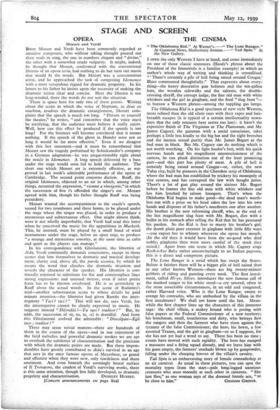THE CINEMA
" The Oklahoma Kid." At Warner's.—" The Lone Ranger." At Gaumont News, Shaftesbury Avenue.—" Tall Spin." At the New Gallery.
I OPEN the only Western I have at hand, and come immediately on one of those classic sentences (Hardy's phrase about the President of the Immortals is a familiar example) in which an author's whole way of writing and thinking is crystallised.
" There's certainly a pile of hell being raised around Cougar,' Blaze commented thoughtfully." That expresses about every- thing—the heavy decorative gun holsters and the ten-gallon hats, the wooden sidewalks and the saloons, the double- crossing sheriff, the corrupt judge, the fine old man with white whiskers and the girl in gingham, and the final " slug feast "- to borrow a Western phrase—among the toppling gas lamps. The Oklahoma Kid is a good specimen of neW style Western, more refined than the old silent ones with their rapes and hair- breadth escapes (it is typical of a certain intellectuality nowa- days that the only rescuers here arrive too late): it hasn't the expensive finish of The Virginian or The Plainsman, and Mr. James Cagney, the gunman with a social conscience, takes perhaps a little less kindly to the big hat and the tight breeches and the intense sexual purity than Mr. James Bogart as the bad man in black. But Mr. Cagney can do nothing which is not worth watching. On his light hoofer's feet, with his quick nervous hands and his magnificent unconsciousness of the camera, he can pluck distinction out of the least promising part—and this part has plenty of meat. A pile of hell is certainly being raised around Cougar—or, rather, the new Tulsa city, built by pioneers in the Cherokee strip of Oklahoma, where the bad man has established by trickery his monopoly of vice centres, and has corrupted the law with bought juries.
There's a lot of gun play around the sinister Mr. Bogart before he frames the fine old man with white whiskers and has him lynched by saloon loungers. That's when the Oklahoma Kid begins to make good—the dead man's worth- less son with a price on his head takes the law into his own hands and disposes of his father's murderers one after another.
His brother is the new reforming sheriff, who, at the end of the last magnificent slug feast with Mr. Bogart, dies with a bullet in his stomach after telling the Kid that he has procured
his pardon. So the Kid is free to- marry his brother's girl,
the dumb plain pure creature in gingham with little filly ways —you expect her to whinny whenever she opens her mouth.
(In the old days it would have been the no-good who died nobly; ginghams then were more careful of the stock they raised.) Apart from one scene in which Mr. Cagney sings Rock-a-bye Baby rather unconvincingly to an Indian papoose, this is a direct and competent picture.
The Lone Ranger is a serial which has swept the States. Before it finishes there will be a bigger pile of hell raised than in any other known Western—there are big twenty-minute gobbets of riding and gunning' every week. The first instal- ment, called Hi-yo, Silver, introduces the now famous call of the masked ranger to his white steed—a cry uttered, often in the most unsuitable circumstances, in an odd and congested, rather Harvard voice. Who is the Lone Ranger, sworn to avenge his comrades, who are ambushed by the villain in the first instalment? We shall not know until the last. Mean- while the first chapter lines up the characters of this immense saga : the chief villain, a snakey hound who is posing with false papers as the Federal Commissioner of a new territory; his henchman, small, treacherous and dirty, who betrays first the rangers and then the farmers who have risen against the tyranny of the false Commissioner; the hero, his horse, a few assorted Texans, and the girl in gingham—or so I suppose, for she has not yet had a word to say. There has been no time ; events have moved with such rapidity. The hero has escaped a massacre and a firing squad already, and we leave him with his guns empty, the farmers' stockade blown up by guniowder, falling under the charging hooves of the villain's cavalry.
Tail Spin is an embarrassing story of female comradeship at an air carnival. As usual in these pictures, you can spot the mortality types from the start—pale long-legged uxorious creatures who stare moonily at each other in canteens. " She just flies," as one woman says of the doomed female ace, " to


















































 Previous page
Previous page